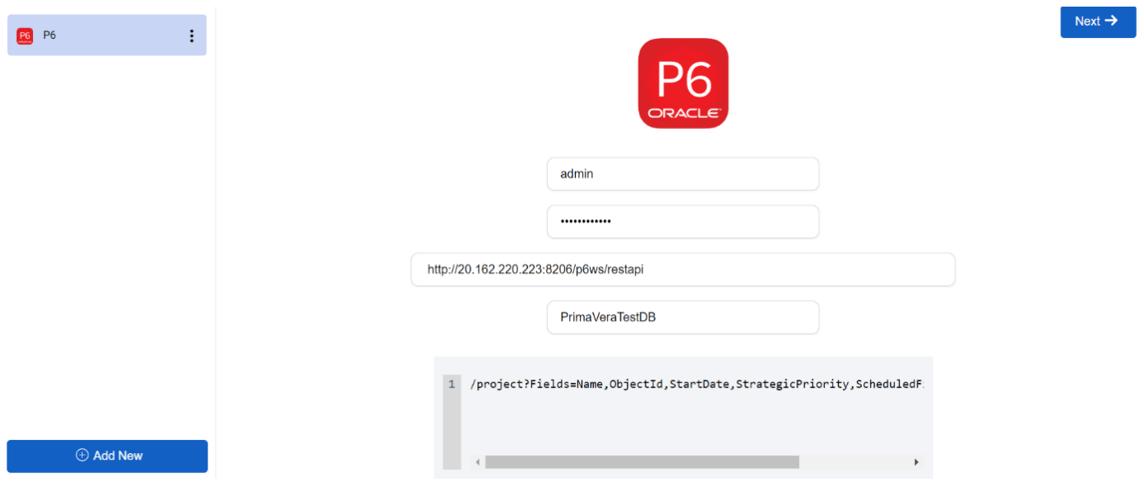Primavera P6 Connector
Authentication Methods
To authenticate, you’ll need to enter username, password, URL and database credentials from your P6 account.
You’ll also need to enter a string specifying which table and which fields you’d like from that table to be pushed into your story. In the example below we’re pulling data from the projects table and getting the fields Name, Object ID, Start Date etc.

Tip: If you want more information on using REST Apis, you can find it at this link: http://20.162.220.223:8206/p6ws/swagger-ui/index.jsp accessible at the bottom of the “Connect” screen by clicking ‘View Api Documentation’.
Typical use-cases
Many people have project data stored in P6 that they may want to import to a SharpCloud story. This connector allows you to create, update and delete items based on data in P6.
How to Use the Connector
Once you have created a P6 connector, you will be presented with the “Connect” screen (which is standard for all connectors). This is where you will carry out the authentication described above.
Once this is complete, you can now press “Next” to move to the mapping section of the connector, where you will select the table of data, which category you want to import the data into and map the fields in P6 to the attributes in the SharpCloud story.
You can view the Source Data, which is the data from P6 and how SharpCloud reads this by clicking on the “View Source Data” button.
.png?width=1144&height=474&name=Oracle-P6-Connector(1).png)
You can see we are bringing in the project Table and importing them into Category 1.
You need to nominate an External ID (a unique identifier for each item) in the “External ID” column.
A unique number is created for each row in the list which can be used for the External ID. It is a lot better to bring in your own unique field and nominate that field as the External ID to avoid incorrect data mapping/loss. In this example, we have done that with the ‘ObjectId’ field.
For the other fields, you can either map the column to existing attributes in your story or by selecting “(NEW)” which will create a new attribute/property in your story and you can select it’s type.
.png?width=1144&height=476&name=Oracle-P6-Connector(2).png)
Note: For Tag Groups and Categories, these will need to pre-exist before mapping onto those fields – you can access the Story Setup to perform those actions from the top of the screen.
You can provide a filter on the incoming items by using the drop-down on the far right.
For more advanced actions and queries, you can access the underlying SQL queries to discover and edit how you wish the data be imported and perform special functions such as JOIN. To access the SQL, simply use the toggle in the top left that says “Show Advanced SQL”:
.png?width=1144&height=474&name=Oracle-P6-Connector(3).png)
Note: Once you edit the SQL, you will not be able to return to the drop-down version of the mapping as there are SQL functions that can be performed here that are not accommodated in the drop-down version.
Once you are happy with the mappings/SQL, press Next to show a preview of what items are going to be created and the additional information:
.png?width=1144&height=476&name=Oracle-P6-Connector(4).png)
You can see the rows in blue are new items that will be created if you click the synchronise button. Modified values/cells (where the item value is different from the source data and SharpCloud) will be shown in orange.
Synchronise: Press this button to actually commit the changes to the SharpCloud story. If the commit is successful it will show a summary of the changes made.
Delete Records from story (Default = true): The default setting for this option is true which means deleted records from your data source (Excel workbook in this case) will be also be deleted in SharpCloud. E.g. if your data source contains records for items A, B and C, and later the data source only contains A and C, item B will be deleted from SharpCloud.
When you are happy that your connector is transferring the right data in the right way, you can “Publish” it. A published connector cannot be edited anymore and can be run by anyone who has admin access to the story.
Note: The credentials of the user who published the connector are used to read from the data source and update the story.
.jpg?width=300&name=Website_GeneralCTA.v2(optimized).jpg)
Contact our expert team
Whether it's to discuss functionality, your subscription, or anything else, we strive to give you the best guidance.
Get in touch